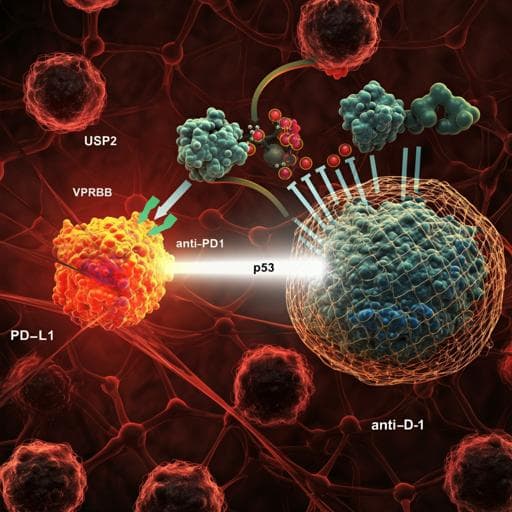
Medicine and Health
Targeting USP2 regulation of VPRBP-mediated degradation of p53 and PD-L1 for cancer therapy
J. Yi, O. Tavana, et al.
Exciting discoveries in cancer therapy show that targeting the USP2-VPRBP axis can effectively reactivate p53 and reduce toxicity compared to traditional Mdm2 inhibitors. This innovative approach, explored by authors Jingjie Yi, Omid Tavana, Huan Li, Donglai Wang, Richard J. Baer, and Wei Gu, demonstrates complete tumor regression in wild-type p53 tumors with the combination of a USP2 inhibitor and anti-PD1 antibody.
~3 min • Beginner • English
Introduction
The study addresses the need for alternative strategies to therapeutically reactivate p53 tumor suppressor function in cancers that retain wild-type TP53, given the dose-limiting toxicities of Mdm2 inhibitors in clinical trials. Mdm2 and p53 form a negative feedback loop critical for maintaining normal tissue homeostasis; disrupting this loop with Mdm2 inhibitors unleashes p53 activity in normal tissues and causes severe toxicity. Prior work suggests that enhancing p53 function without compromising Mdm2-mediated regulation may avoid toxicity (e.g., Super-p53 mice with intact Mdm2). VPRBP (DCAF1) has been identified as a corepressor and E3 ligase adaptor that represses p53 transcription and promotes its ubiquitin-mediated degradation independently of Mdm2, and is overexpressed in several cancers. The authors hypothesize that targeting the USP2-VPRBP pathway—specifically by inhibiting USP2, a deubiquitinase that stabilizes VPRBP—can activate p53 in tumors while preserving the p53-Mdm2 feedback in normal tissues, and that this axis also regulates PD-L1 with implications for combining with PD-1/PD-L1 checkpoint blockade.
Literature Review
- Clinical Mdm2 inhibitors effectively reactivate p53 but have significant toxicities (myelosuppression, GI symptoms, weight loss, fatigue, cardiovascular toxicity, and treatment-related death), reflecting disruption of the p53-Mdm2 negative feedback loop.
- Genetic evidence: Mdm2-null mice are embryonically lethal unless p53 is also inactivated; compromising Mdm2 regulation of p53 (Mdm2 P2 promoter mutants) causes catastrophic myeloablation upon DNA damage. By contrast, Super-p53 mice with intact Mdm2 regulation show enhanced p53 responses without toxicity.
- p53 function is dynamically regulated by post-translational modifications; acidic domain-containing cofactors act as readers of unacetylated p53. VPRBP is an acidic domain-containing corepressor, binds p53 C-terminus, represses p53-mediated transcription, and participates in p53 ubiquitination and degradation in vivo.
- PD-L1 expression in tumors is induced by IFNγ via IRF1; PD-L1 levels correlate positively with response to PD-1/PD-L1 blockade.
- USP2-knockout mice develop normally with mild phenotypes, suggesting limited essential roles in normal tissue homeostasis.
These observations motivate exploring USP2/VPRBP as a therapeutic target to activate p53 while mitigating toxicity and potentially synergizing with immune checkpoint therapy.
Methodology
- Cell lines: Human cancer lines (U2OS, H1299, H460, A375, CAL33, A549, SKBR3, MDA-MB-231, MDA-MB-435, HUCCT1, HEK293T) and murine lines (EMT6, EMT6 p53-null CRISPR, 4T1, B16F10, RM-1). Cells cultured in DMEM with 10% FBS, penicillin/streptomycin at 37°C, 5% CO2. Cell lines were not authenticated.
- Gene perturbations:
- siRNA knockdown: VPRBP, p53, USP2, DDB1, CUL4A/B using commercial siRNA pools; controls included non-targeting siRNAs.
- shRNA: Four independent shRNAs against VPRBP for stable knockdown in EMT6 (lentiviral transduction).
- CRISPR/Cas9 knockouts: Generated IRF1-null H1299; USP2-knockout H1299 via double nickase plasmids; p53-null EMT6 using inducible Cas9 and gRNA. Knockouts validated by immunoblot and sequencing.
- Protein interaction and mechanistic assays:
- Co-immunoprecipitation (co-IP) for interactions among VPRBP, IRF1, PD-L1, USP2 at exogenous and endogenous levels.
- GST pull-down assays with purified proteins to test direct interactions: VPRBP with IRF1; VPRBP with PD-L1; VPRBP with USP2; domain mapping for PD-L1 (ICD aa231–290) and VPRBP N-terminus required for binding.
- Ubiquitination assays under denaturing conditions to assess VPRBP-induced PD-L1 ubiquitination and USP2 effects on VPRBP ubiquitination.
- Cycloheximide (CHX) chase assays to measure protein half-lives of PD-L1 and VPRBP in control vs knockdown/KO backgrounds.
- Luciferase reporter assays: PD-L1 promoter (-456 to +151) containing two IRF1 sites to assess IRF1 activation and VPRBP repression; tested with WT and mutant VPRBP (ΔAD/AAD lacking IRF1-binding; ΔE3 defective for CUL4-DDB1 interaction).
- qRT-PCR for mRNA levels (PD-L1, USP2, VPRBP) and p53 targets; Western blots for PD-L1, VPRBP, USP2, p53, p21, PUMA, MDM2, DDB1, CUL4A/B, IRF1.
- Small molecule treatments:
- USP2 inhibitors: ML364 (typically 20 µM, 72 h in vitro; 30 mg/kg daily IP for 15 days in vivo), LCAHA (20 µM, 72 h).
- Mdm2 inhibitor: RG7388 (idasanutlin) at 1–10 µM for rescue of Mdm2-mediated p53 degradation in vitro.
- CUL4 E3 inhibitor: MLN4924 to assess dependence of VPRBP-mediated PD-L1 degradation on CRL4 activity; lysosomal inhibitor BafA1 as control.
- In vivo studies:
- Xenografts in immunodeficient nude mice: EMT6 (WT or p53-null) with/without VPRBP knockdown; tumor dissection and weight measurement ~2 weeks post-inoculation.
- Syngeneic models in immunocompetent mice: EMT6-Luc in Balb/c females; RM-1 in C57BL/6 males; treatment arms included vehicle, ML364, anti-PD-1 mAb, and combination. Anti-PD-1 dosing: 200 µg/mouse IP, 4 injections over ~10 days. Tumor volumes monitored; IVIS imaging for EMT6-Luc.
- Immune profiling: Flow cytometry of tumor-infiltrating lymphocytes (TILs): CD4+, CD8+, granzyme B+; CD4/CD8 depletion assays using depleting antibodies to dissect effector populations.
- Toxicity assessment: Balb/c mice treated with ML364 (30 mg/kg IP daily for 10 days); complete blood counts (WBC, lymphocytes), histology (H&E) of bone marrow, spleen, and major organs; body weight monitoring.
- Statistics: Unpaired two-tailed t-tests for in vitro assays; log-rank tests for survival analyses; data presented as mean ± SD/SEM with biological replicates as indicated.
Key Findings
- VPRBP suppresses p53 activity and regulates PD-L1 independently of p53:
- VPRBP knockdown elevated p53 target genes (p21, TIGAR, PUMA, MDM2) in p53-WT U2OS but not p53-null cells.
- VPRBP depletion increased PD-L1 mRNA and protein across multiple cell lines regardless of p53 status; PD-L1 upregulation persisted with concurrent p53 knockdown and in p53-null cells.
- Mechanisms of PD-L1 regulation by VPRBP:
- VPRBP directly binds IRF1 and represses IRF1-driven PD-L1 promoter activity; VPRBP co-expression reduced IRF1-induced endogenous PD-L1 without altering IRF1 levels.
- IRF1 knockout abrogated IFNγ-induced PD-L1 expression; VPRBP knockdown failed to elevate PD-L1 in IRF1-null cells, indicating dependence on IRF1.
- VPRBP also binds PD-L1 (via PD-L1 C-terminal intracellular domain, aa231–290) and promotes its ubiquitination and proteasomal degradation through CRL4VPRBP E3 ligase; DDB1 or CUL4A/B knockdown upregulated PD-L1; MLN4924 blocked VPRBP-mediated PD-L1 degradation. VPRBP mutants deficient in PD-L1 binding or E3 association failed to induce degradation.
- VPRBP inhibition suppresses tumor growth in vivo in a p53-dependent manner:
- shVPRBP reduced growth of EMT6 tumors in nude mice; effect largely lost in p53-null EMT6 xenografts.
- In immunocompetent Balb/c mice, shVPRBP alone modestly reduced EMT6 tumor growth in a subset (2/11), but combination with anti-PD-1 suppressed growth in all mice (11/11) and improved survival (log-rank p<0.0001), with increased CD8+/granzyme B+ TILs.
- USP2 is a deubiquitinase that stabilizes VPRBP:
- USP2 physically interacts with VPRBP (co-IP, direct GST pull-down). Wild-type USP2, but not catalytic mutant C276A, stabilized VPRBP and reduced its ubiquitination.
- USP2 knockdown or CRISPR knockout reduced VPRBP protein (not mRNA) and shortened its half-life.
- USP2 inhibition activates p53 while preserving Mdm2 regulation and elevating PD-L1:
- USP2 inhibitors (ML364, LCAHA) destabilized VPRBP, increased PD-L1, and activated p53 targets (p21, PUMA, MDM2) in p53-WT lines; PD-L1 induction occurred irrespective of p53 status.
- ML364 did not block Mdm2-mediated p53 degradation, unlike RG7388; Usp2-null cells retained intact p53-Mdm2 feedback (normal Mdm2 half-life; exogenous Mdm2 degraded p53; p53 induced Mdm2).
- Therapeutic efficacy and safety in vivo:
- ML364 (30 mg/kg daily x15) or anti-PD-1 alone conferred long-term survival in subsets of EMT6-bearing Balb/c mice (ML364 ~3/8; anti-PD-1 ~5/8), whereas combination achieved complete responses with long-term survival in all mice (9/9), with marked tumor regression by bioluminescence.
- In p53-null EMT6 tumors, combination therapy was much less potent (long-term survival 3/6), indicating dependence on tumor cell-autonomous p53 activity.
- Similar synergy reproduced in RM-1 tumors without apparent toxicity.
- CD8+ T cells were essential for combination efficacy (CD8 depletion abrogated effect; CD4 depletion had little effect).
- Toxicity: ML364 treatment showed no significant hematologic toxicity (WBC, lymphocytes not different from vehicle), no histologic damage to bone marrow/spleen/major organs, and stable body weight.
Discussion
The study demonstrates that targeting the USP2-VPRBP axis activates p53 tumor suppressor function while simultaneously modulating PD-L1 through IRF1 repression and ubiquitin-mediated degradation. By destabilizing VPRBP via USP2 inhibition, p53 transcriptional activity is enhanced in tumor cells; critically, this occurs without disrupting the essential p53-Mdm2 negative feedback loop, likely avoiding the severe toxicities observed with Mdm2 inhibitors. The upregulation of PD-L1 resulting from VPRBP/USP2 inhibition presents a paradox for anti-tumor immunity but also creates a vulnerability: elevated PD-L1 sensitizes tumors to PD-1/PD-L1 checkpoint blockade. Consequently, combining a USP2 inhibitor with anti-PD-1 therapy elicits robust anti-tumor responses, increases cytotoxic CD8+ TILs, and achieves complete tumor regression and durable survival in p53-WT tumor models. The results underscore a therapeutically exploitable strategy to reactivate p53 in a manner compatible with normal tissue homeostasis, and they provide mechanistic insight linking deubiquitination, transcriptional repression, and immune checkpoint regulation via VPRBP.
Conclusion
This work identifies USP2 as a key deubiquitinase that stabilizes VPRBP, a dual regulator of p53 and PD-L1. Pharmacologic or genetic inactivation of USP2 destabilizes VPRBP, thereby activating p53 and increasing PD-L1 expression through IRF1-dependent transcription and relief of CRL4VPRBP-mediated PD-L1 degradation. Unlike Mdm2 inhibition, USP2 inhibition preserves the p53-Mdm2 feedback loop and shows no obvious toxicity in vivo. Therapeutically, USP2 inhibition alone partially suppresses tumors, but in combination with PD-1/PD-L1 blockade, it drives complete regression and long-term survival in p53-WT murine tumor models, with efficacy dependent on CD8+ T cells and tumor cell-autonomous p53. Future research should define the precise mechanisms underlying the favorable safety profile of USP2 inhibition, investigate potential p53-independent roles of USP2 in tumorigenesis and toxicity, and evaluate this combination strategy in clinical trials, including in tumors refractory to immunotherapy.
Limitations
- The precise mechanism by which USP2 inhibition avoids toxicity compared to Mdm2 inhibition remains unresolved and requires further study.
- Potential p53-independent functions of USP2 that may influence efficacy or toxicity were not fully delineated.
- Efficacy was demonstrated in preclinical cell line and murine syngeneic/xenograft models; clinical translation remains to be tested.
- Cell lines used were not authenticated, which may impact generalizability of some in vitro findings.
Related Publications
Explore these studies to deepen your understanding of the subject.







